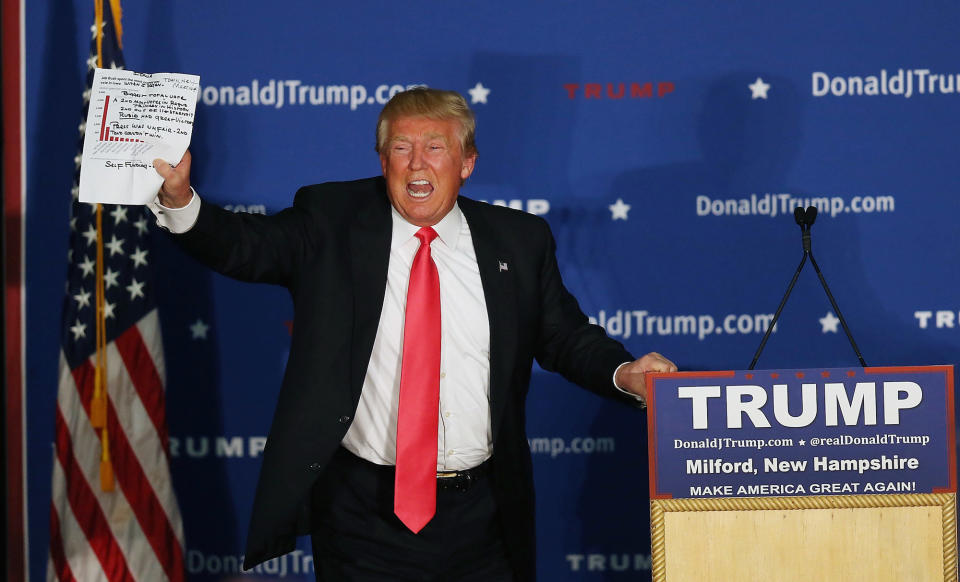The 9 Most Absurd Parts of President Trump's Budget Proposal

President Trump released his proposal for a federal budget on Wednesday, and it ain't pretty. It is only a proposal, and any prospective budget will undergo countless shifts and changes before it passes. But this first look is a stunning indication of the Trump administration's priorities. For that matter, it shows us what areas appear to be non-priorities: public education, climate change, cures to deadly and pandemic diseases, and preventing citizens from freezing in the winter. Here are nine important areas to keep an eye on:
Low Income Home Energy Assistance Program
The initiative provides $3 billion annually to help heat poor Americans' homes during the winter. This budget would do away with it entirely. After all, staying warm is just another form of entitlement. Freezing for freedom!
The Appalachian Regional Commission
One constituency that helped power Donald Trump to the presidency was the oft-forgotten people of Appalachia. The president has resolved to eliminate the Appalachian Regional Commission, which The Columbus Dispatch describes as "a federal-state-local partnership aimed at serving as a regional economic development agency. The agency, established by Congress in 1965, includes Ohio and 12 other Appalachian states and aims to invest in business development in the region; in worker education and training; and in infrastructure."

Meals on Wheels
Trump's proposed budget completely eliminates the Community Development Block Grant, which provides $3 billion every year for, according to The Washington Post, "targeted projects related to affordable housing, community development and homelessness programs." Among those is the Meals on Wheels program, which provides meals-and vital human contact-for older, impoverished Americans, many of whom are largely home-bound. According to MOW, one in six American seniors struggles with hunger, and the organization claims it saves the nation about $34 billion a year in medical expenses by decreasing the rate of falls for seniors. The program gets the vast majority of its funding from non-government sources, but the proposal still seems unnecessarily harsh.
It's also part of a rash of cuts to programs that benefit lower-income Americans.
Education and After-School Programs
This budget would cut the Department of Education's budget by 13 percent, or $9 billion. That includes drastic cuts to Pell Grants and other programs designed to help poorer students afford college. It would also eliminate 21st Century Community Learning Centers, which provide after-school programs for children in disadvantaged areas.
It would, however, provide $250 million for a new "school choice" program, the kind championed by Education Secretary Betsy DeVos, creating $168 million in funding for charter schools. It also adds $1 billion to Title I, "a grant program that specifically targets schools serving disadvantaged students" according to HuffPost. That's intended to emphasize "portability," where funding can follow a student if he or she switches schools. That was a hotly contested issue during debate of the most recent federal education law, when it was defeated. At the time, Democrats said it would ultimately strip schools serving poor students of funding.

The National Endowment for the Arts
For the first time since the programs were created in 1965, a sitting president has called for the elimination of the National Endowment for the Arts and the National Endowment for the Humanities, along with public broadcasting outlets like PBS and National Public Radio. The two endowments have a combined budget of $300 million annually, which is functionally non-existent on a pie chart of the $1.1 trillion discretionary spending budget. Meanwhile, these initiatives have served, in The New York Times' estimation, as "deeply valued financial lifelines and highly coveted honors for artists, musicians, writers, and scholars for decades." No matter-they must go.
The National Institutes of Health
The budget would see the NIH's budget cut by $5.8 billion, or a full 20 percent. The Atlantic describes the agency as "the world's engine of biomedical research," and adds it provides funding to over 300,000 scientists across the world-many of whom will see their work, and their livelihood, at risk. More than that, though, the NIH is a major source of funding for research into cures for chronic conditions like Alzheimer's and in coordinating international efforts to stop the spread of pandemic disease, like Ebola and Zika. Adequately funding the NIH has long been a bipartisan priority: Newt Gingrich, the former Republican Speaker of the House and a Trump adviser has said, "It's irresponsible and shortsighted, not prudent, to let financing for basic research dwindle."

Climate Change
The new budget would savage the funding allotted to the Environmental Protection Agency, eliminating 50 programs and 3,200 positions, according to The Washington Post. The proposal would also slash climate and earth science research funding at NASA and the National Oceanic and Atmospheric Administration. It would eliminate payments to the U.N. Green Climate Fund, a key component of the U.S. commitment to the Paris Climate Accords. And it declares war on funding for clean energy, including an "unspecified cut to the agency's Office of Energy Efficiency and Renewable Energy."
Defense Spending
All of these cuts, of course, are necessary to offset the administration's proposal to increase military spending by $54 billion. Although the United States already spends nearly $600 billion annually on defense-54 percent of federal discretionary spending, and more than the next seven competitors (five of whom are allies) combined-it seems we need to up our game. The budget is not even clear, in The Washington Post's assessment, as to where this massive influx of cash will go. "It would, among other things, acquire new F-35 Joint Strike Fighters and rebuild what it says are depleted munitions inventories," the Post reports. "But it stops short of saying how these new funds would support new tactics to combat the Islamic State." You might remember the F-35 as the plane that recently had trouble flying in a thunderstorm.
Sorry if your livelihood depends on funding from the National Endowment for the Arts! We're going to buy one-and-a-half fighter jets instead.
Oh, and There's the Wall
The budget requests $1.7 billion this year and an additional $2.6 billion in 2018 to begin construction of The Wall. But wait, I thought Mexico was paying for it? Maybe they'll make up the difference on what Republican Senate Majority Leader Mitch McConnell said could be a $15 billion total cost (others have gone up to $25 billion)-although that same McConnell said flatly that our neighbors to the south are not going to pay for it at all.
You Might Also Like

